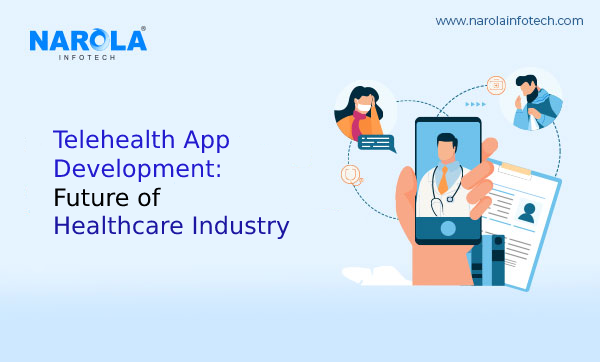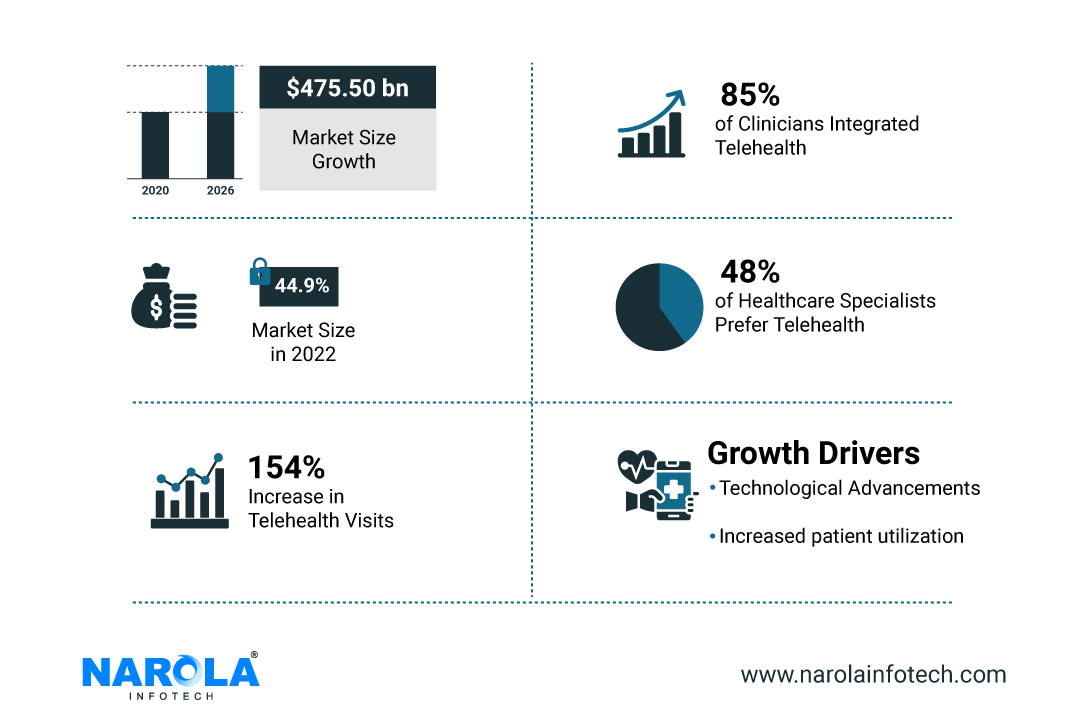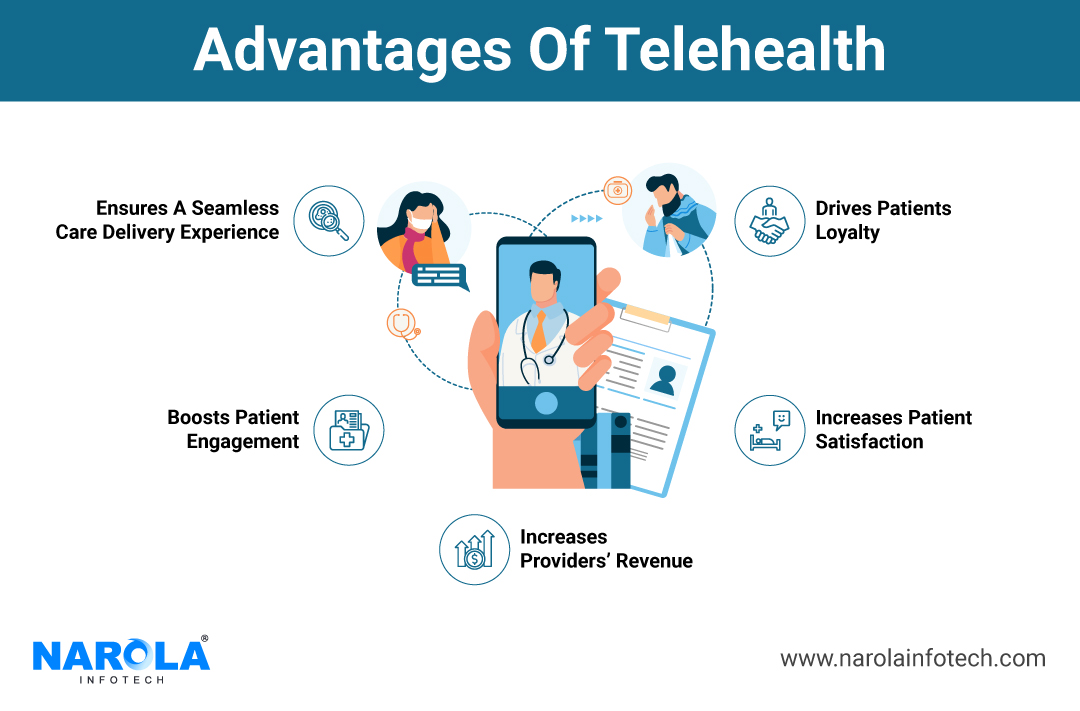Telehealth App Development: The Future of Healthcare Industry
Telehealth Development: The Future of Healthcare Industry

Have you ever called your family physician for assistance at midnight? If you answered yes, you have already utilized a fundamental form of telehealth. But, as a result of the Internet and smartphone revolution, we now have healthcare app solution that make telehealth thriving, efficient, and lifesaving.
For quite some time, telehealth has been the hottest topic in the healthcare industry. It has both feverish and concerned medical professionals. Some fear that telemedicine may endanger the patient-physician connection, but others hope that technology would make healthcare more affordable and accessible.
In this blog, we will address the most frequently asked issues regarding telemedicine. We will also discuss its effect on the healthcare sector.
What is Telehealth Exactly?
Telehealth is the remote delivery of healthcare services using technologies such as video conferencing, telephone calls, and remote monitoring. It enables patients to receive medical care without physically visiting a healthcare center.
This may involve consultations, diagnostics, treatments, and aftercare. It may also involve the remote monitoring of a patient’s vital signs and other health data.
The apps created by Healthcare Software Development make it possible to view this data in real-time and assure their accuracy.
Look at the Statistics of Telehealth Services Growth

History of Telehealth
Telehealth, often known as telemedicine, is the remote delivery of healthcare using technology. Telehealth dates back to the late 1800s when telegraphs and telephones were first used to connect physicians and patients. Yet, telehealth did not acquire hold as a viable mode of healthcare delivery until the 20th century.
In the 1950s and 1960s, new technology such as videoconferencing and remote monitoring devices made telehealth a more viable alternative. In the 1970s and 1980s, the introduction of personal computers and the internet enabled the electronic transmission of medical data and photographs, expanding the capabilities of telehealth.
With the emergence of new technology such as mobile devices and cloud computing, the 1990s and 2000s saw a considerable surge in the use of telehealth. This made it possible to provide the best telehealth services to a broader spectrum of patients, including those in rural and distant places. In the 2010s, telehealth’s popularity increased owing to the COVID-19 pandemic, which brought to light the significance of remote healthcare delivery.
Telehealth Today
In recent years, telehealth has experienced substantial development, particularly during the COVID-19 epidemic. According to industry research, by 2026 the telehealth market is anticipated to reach $475.50 billion. After noticing the benefits of telehealth, a significant number of physicians have incorporated it into their practices, with 85 percent of clinicians employing it.
The increasing number of smartphone users and the incidence of chronic diseases are key growth drivers for telehealth. In addition, 48% of healthcare specialists choose telemedicine as a means of treatment delivery.
Telehealth vs Telemedicine
Despite frequent confusion, telemedicine and telehealth are in fact two distinct concepts. “Tele,” which means “at a distance,” introduces us to the innovative world of telehealthcare or telehealth. Telehealth, a larger word than telemedicine, comprises a vast number of remote healthcare services, bringing treatment to your front door.
Different Types of Telehealth
- Synchronous – The patient connects with a physician in real-time, typically through phone or video.
- Asynchronous — Also denoted by the term “store-and-forward.” There is no actual interaction between clinicians and patients in this setting. The submitted (email) patient information is then retained until it is reviewed by the physician.
- Remote patient monitoring – Patients and providers employ digital technologies to collect and monitor medical and other health information from patients, then electronically transmit this information to healthcare practitioners for further review.
What Services Does Telehealth Provide?
To gain a better understanding of telemedicine and the possibilities it offers, it is necessary to comprehend the services it provides and the methods it employs.
Here are the Three Main Services That it Provides:
1. Patient Monitoring At Remote Locations
In remote settings, patient monitoring is performed with the aid of portable and small devices that remotely gather and transmit patient data to the relevant health agency or diagnostic testing center.
In general, the obtained data consists of vital signs such as ECG readings, blood glucose levels, and other lipid results. Utilizing this data, the telemedicine business supplements the need for on-site healthcare specialists or hospitalization.
2. Peer-to-peer Support
Information pertaining to the health of patients typically involves the usage of wireless internet-connected devices. These gadgets provide users with access to vital health-related information and enable participation in peer-to-peer support groups.
3. Access to Medical Education
Healthcare workers can opt to continue their medical education credentials as specialists, and current medical education is more accessible than ever to individuals in all areas.

There are a number of causes that contribute to telemedicine’s popularity, but the following four have been the most influential in recent years.
1. Improvised Access To Healthcare Services
Telemedicine has given access to healthcare for people in remote regions for more than 50 years. In addition, it has enabled healthcare service providers to reach out to offices outside their immediate network. There is a severe lack of adequate healthcare professionals. Nonetheless, telemedicine has succeeded in bridging the gap between healthcare service seekers and providers.
2. Affordability Of Healthcare Services
Affordability is one reason why telemedicine has become an increasingly evident option for patients. Telemedicine is able to lower healthcare expenditures due to its efficacy, reduced travel time, and patients’ shorter hospital stays. This makes it more cost-effective than standard healthcare practices.
3. Improved Quality Of Healthcare And Related Services
Numerous studies have demonstrated that the utilization of telemedicine has improved the quality of healthcare services. These are equivalent to services rendered during an in-person consultation. Certain healthcare services, such as intensive care for mental health and well-being, have demonstrated that telemedicine outperforms conventional medical treatments.
4. Increase In Demand For Patients
Because telemedicine removes travel time, it reduces patients’ stress tremendously. Several studies have demonstrated an improvement in patient satisfaction over the past few years, which has led to a rise in support for the best telemedicine services.
Telemedicine Software Solutions
As previously said, telemedicine entails little or no face-to-face consultations. It is accessible to patients on their internet-capable electronic devices such as cell phones and desktops.
Yet, this alone is insufficient. There must be a software solution capable of making this achievable. The popularity of Healthcare Technology Solutions such as video calls and virtual clinics has increased. This section of the post will explore the most popular software options for telemedicine industry healthcare providers.
Some examples of telehealth software solutions include
- Software for video conferencing enables real-time, face-to-face discussions between patients and healthcare professionals. These may include features such as screen sharing and virtual whiteboards and can be utilized for both diagnosis and treatment.
- Software for Remote Patient Monitoring (RPM) enables the remote, continuous monitoring of a patient’s vital indicators, such as heart rate and blood pressure. This can be used to monitor a patient’s progress and enable early detection of future health problems.
- Software for Electronic Health Records (EHR) enables the digital storing and sharing of patient health information, including medical history and test results. This can be used to ensure that healthcare providers have access to the necessary information to make educated care decisions.
- Telemedicine Carts: This is a rolling cart containing a computer, monitor, and camera that can be rolled up to a patient’s bedside and used for virtual consultations.
- These mobile applications may be downloaded into a patient’s smartphone or tablet for mobile health (mHealth). Then, they can access health information, monitor symptoms, and contact healthcare experts.
Telehealth: The Driving Force Behind Healthcare App Development
Telehealth is mostly dependent on a stable Internet connection and software solutions. This includes applications that allow patients to connect remotely with their healthcare providers.
The demand for custom healthcare software development companies specializing in healthcare applications has increased. Given the rapidly expanding use of telemedicine procedures, the demand for bespoke healthcare app solutions has skyrocketed. 
Role of Narola Infotech
If you are a medical practitioner or the owner of a healthcare service-providing firm seeking to provide telemedicine/telehealth services, we feel you must have knowledge of the telemedicine industry.
Nonetheless, you may require a professional solution for healthcare software development services.
Narola Infotech is a telehealth app development company in USA. The development of Healthcare Software is one of our primary areas of competence. We are dedicated to providing superior solutions, particularly for new healthcare industry solutions such as telemedicine.
As we already know, telemedicine is not a new trend, but it is one that is on the rise. Our team of professionals includes some of the earliest pioneers in telemedicine application development. Our healthcare app developers are highly qualified and accredited, specializing in every type of healthcare development the market has ever encountered.






